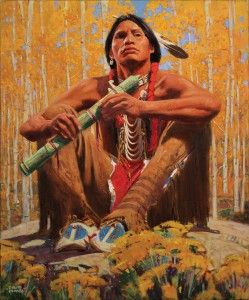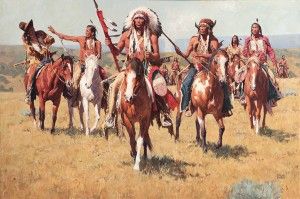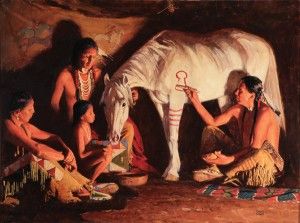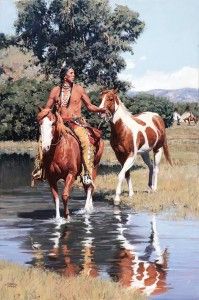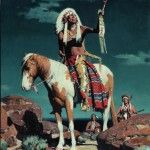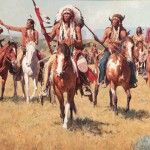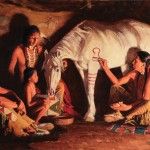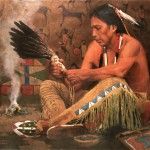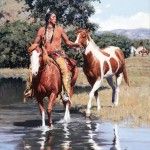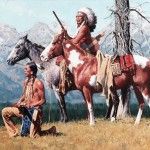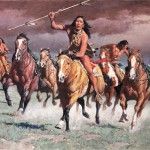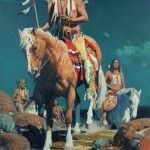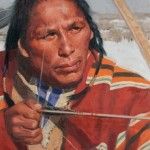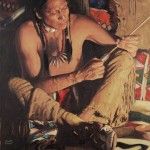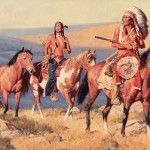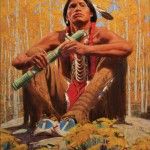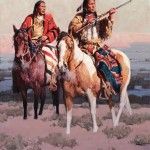David Mann conveys the dignity and humanity of 19th-century Native Americans
By Gussie Fauntleroy
This story was featured in the July 2012 issue of Southwest Art magazine. Order the Southwest Art magazine July 2012 print edition here, or purchase the Southwest Art magazine July 2012 digital download here. Or simply click here to subscribe to Southwest Art magazine and never miss a story!
Even as a boy, David Mann understood that beneath the adventure of 19th-century Plains Indian life was the far-less-romantic reality of hardship and close-to-the-bone survival. He knew, even then, that he was grateful for the comforts of his life in Bountiful, UT, where he vicariously enjoyed the Old West in books featuring the imagery of artists like Alfred Jacob Miller, Wesley Dennis, Will James, Frederic Remington, and Charles M. Russell.
But it wasn’t until Mann was 19, serving as a Mormon missionary among Apache, Navajo, Pueblo, and other tribes in the Southwest, that he began to fully appreciate how life in a remote, nonmodernized setting could carve a culture of dignity and deep spiritual strength out of the challenges and joys of daily life. The experience of traveling to isolated homes in the vast dirt-road distances of the Navajo Reservation, in particular, opened Mann’s eyes to realities that were foreign to his own.
On one such occasion, he and a missionary companion knocked on the door of a remote hogan, the traditional round structure of the Navajo, as dark was gathering on a chilly night. A voice responded from within. Mann opened the door to find an elderly couple ready for sleep on a mattress on the floor. There was no fire in the woodstove, and the old man and woman were covered in layers of blankets for warmth. “I was quite stunned by that,” the artist recalls. “It made me realize how difficult life could be, just for survival. It gave me even more respect for the toughness of early Native Americans and how they lived so close to the earth.”
In his award-winning paintings of Native Americans prior to the mid-1800s, it is this quality of calm strength, as well as a sense of shared humanity, that Mann attempts to convey. Collectors are drawn to his work at such prestigious annual shows as the Prix de West Invitational in Oklahoma City and the Masters of the American West in Los Angeles, among others.
David Mann’s path to painting
As a boy, Mann’s imagination was fed not only by imagery of the Old West but also by tales of history and stories of Indians from many sources. His father, a farm-journal writer and photographer and a weekend painter, was an avid history buff who brought home books and textbooks from secondhand stores. Wherever the family traveled, he regaled them with facts about the past, from Lake Bonneville’s ancient history to the life of pioneers. “He gave me an appreciation of a sense of place,” Mann reflects.
From his mother came firsthand stories of life in one of the most remote and isolated parts of Utah. As the daughter of a sheepherder who was also the local Mormon bishop, she remembered Native Americans coming to her house to talk with her father when she was a girl. Later, to her own children she read such classics as White Indian Boy: My Life Among the Shoshones by Elijah Nicholas Wilson. The true story recounts the experiences of an 11-year-old pioneer boy in the Great Salt Lake Basin who ran away from home and lived among the Shoshone Indians for two years.
Mann’s early influences also included seeing and enjoying original art. Among his favorite activities was visiting Salt Lake City galleries and art museums with his father. Young David also loved to watch his father paint, taking in the historical, landscape, and occasional American Indian subjects on his father’s canvases. Inspired by these formative experiences and his own passion for drawing and painting, he was certain of his future career—until his father heard about his plans. “I always figured I would be an artist, although career-wise it was real fuzzy; I didn’t know how that worked,” he recalls. “In high school I told my dad I wanted to be an artist. He said that was a bad idea. He said, ‘Do you know how many $100 paintings you need to sell to provide for a family?’” The question instilled enough doubt to temporarily put the brakes on a would-be professional artist’s dream.
But while visions of a painting career were tucked away following high school, Mann’s interest in American Indians was only heightened by his time spent among tribes in the Southwest. He had no input on where he would serve his two-year mission assignment; the Mormon Church could have sent him anywhere. So when he received a letter informing him of his destination, he was “quite astonished,” he says, “because that is exactly where I wanted to go.”
While Mann’s time in the Southwest reinforced his appreciation for the earth-connected ways of 19th-century tribes, it also dissolved any concept of Indians as “Wild West” movie icons, replacing it with a knowledge of Native Americans as real people in a contemporary world. These real-life relationships would later include Sioux, Apache, Navajo, and Omaha models for his paintings, some of whom he has worked with for many years.
Returning to Utah after his mission, Mann earned an art education degree at Weber State University in Ogden and went on to what he wryly describes as “one amazing year” of teaching school. “I was not a disciplinarian, not a record keeper. I thought everyone should do art because they loved it,” he grins, “but the school officials didn’t see it that way.” So he moved on to other occupations, including 10 years as a librarian at the state library, always painting in his free time. Eventually his wife volunteered to support the family for five years while Mann focused on getting his art career off the ground. He has been at the easel full time since then.
David Mann’s art comes to life
Today the 63-year-old artist’s easel stands in his home studio in the foothills outside Hyrum, UT. Mountain views provide an appropriate backdrop for his collection of Native American artifacts and clothing—some of which he and his wife have made themselves—that appear in his paintings. Deer and elk wander through the property, and the yipping of coyotes often pierces the night. While Mann owns no horses himself, a number of his neighbors do, allowing him to frequently spend time with horses and ride.
In fact, horses play a vital role in many of Mann’s paintings, as they did in the lives of Plains Indians in pre-reservation days. In WAY OF THE CHEYENNE, a group of Native men on horseback rides directly toward the viewer. The central figure is a strong, bare-chested warrior in a traditional headdress, carrying a spear. To one side a rider wears a red cotton shirt, while on the other side a young warrior reaches out to grab a settler’s hat from the man riding alongside him. A trace of smoke rising from behind a hill in the background implies an “event,” as Mann puts it, from which the hat is a trophy. “I liked the idea that this is business for these warriors, but they’re still human, with personalities, and they laugh and joke and move on,” he explains.
Mann’s paintings are noted for their rich colors and skilled rendering of both daytime scenes and those illuminated by the moon. THE MEDICINE SIGN places a horse and humans in another kind of light: the flickering warmth of a fire inside a teepee or lodge, where a warrior paints symbols on his horse in preparation for battle. A young boy watches from his position near the horse’s head, a detail the artist enjoys for its suggestion of tradition passed down from one generation to the next.
While tribal rivalries, raids on settlers, and dramatic scenarios were certainly part of the Plains Indian experience, Mann’s focus, most often, is a quieter perspective infused with the feeling of day-to-day life. Such is the case with SIOUX SUMMER, in which a man leads his horse across a shallow stream. In the distant background are the teepees of his people’s camp. “It’s not about fighting, not about survival,” the artist observes. “It’s the good part of life and freedom in a beautiful environment. It’s a slice of that life that brings satisfaction and peace.”
For Mann, authenticity in the details of historic clothing, artifacts, and activities of early Plains Indians and Navajos is essential—although it never takes precedence over the artistic vision itself, he says. After extensive research, he envisions a scene and engages one or more Native Americans as models. He selects clothing and artifacts, often choreographing and photographing a series of poses, and then uses these reference photos as he paints. A scene may come alive, for instance, as a muscular, serene, long-haired Omaha man, dressed in beaded leather leggings, moccasins, and a loincloth, sits astride a horse and cradles a model 66 Winchester in his arms. “Then you get the sun gleaming off the feathers and shadows carving out his features,” the artist relates. “That’s really when the magic starts to happen.”
representation
Legacy Gallery, Scottsdale, AZ, and Jackson, WY.
Featured in the July 2012 issue of Southwest Art magazine–click below to purchase:
Southwest Art magazine July 2012 digital download
Southwest Art magazine July 2012 print edition
Or click here to subscribe to Southwest Art magazine and never miss a story!
- David Mann, Tribute to the Moon, oil, 30 x 24.
- David Mann, Way of the Cheyenne, oil, 40 x 60.
- David Mann, The Medicine Sign, oil, 36 x 48.
- David Mann, Incense Fan, oil, 20 x 24.
- David Mann, Sioux Summer, oil, 36 x 24.
- David Mann, Shoshoni Ridge, oil, 30 x 40.
- David Mann, Red Sky Warriors, oil, 36 x 48.
- David Mann, Omen in the Sky, oil, 36 x 24.
- David Mann, Winter Hunt, oil, 16 x 12.
- David Mann, Dogwood Arrow, oil, 24 x 20.
- David Mann, Cheyenne Ridge, oil, 24 x 36.
- David Mann, Autumn Flute Song, oil, 24 x 20.
- David Mann, A Long Shot, oil, 30 x 24.
MORE RESOURCES FOR ART COLLECTORS & ENTHUSIASTS
• Subscribe to Southwest Art magazine
• Learn how to paint & how to draw with downloads, books, videos & more from North Light Shop
• Sign up for your Southwest Art email newsletter & download a FREE ebook






